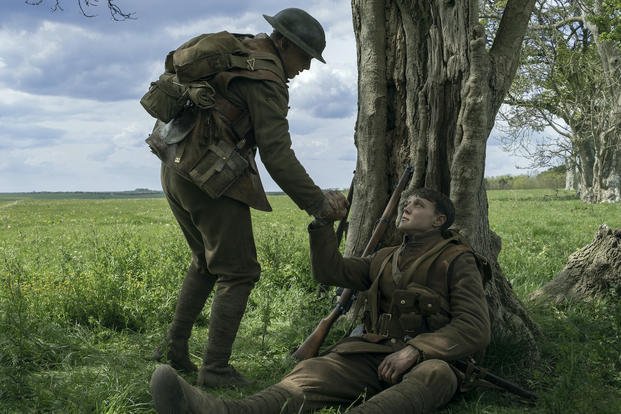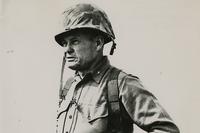"1917" (out now on 4K UHD, Blu-ray, DVD and Digital) is one of those rare movies whose impact seems to keep coming in waves long after you first see it. Since its release last December, I've thought about it almost every day and had dozens of conversations with people who were truly moved by its depiction of a desperate mission to the front lines during World War I.
If you already own a 4K television, this home video release makes a strong case for upgrading to a 4K Blu-ray player while you're stuck at home for the next few weeks. There's no streaming service that can match the presentation that you'll get from this release, and all of its documentary bonus features are presented on the 4K disc.
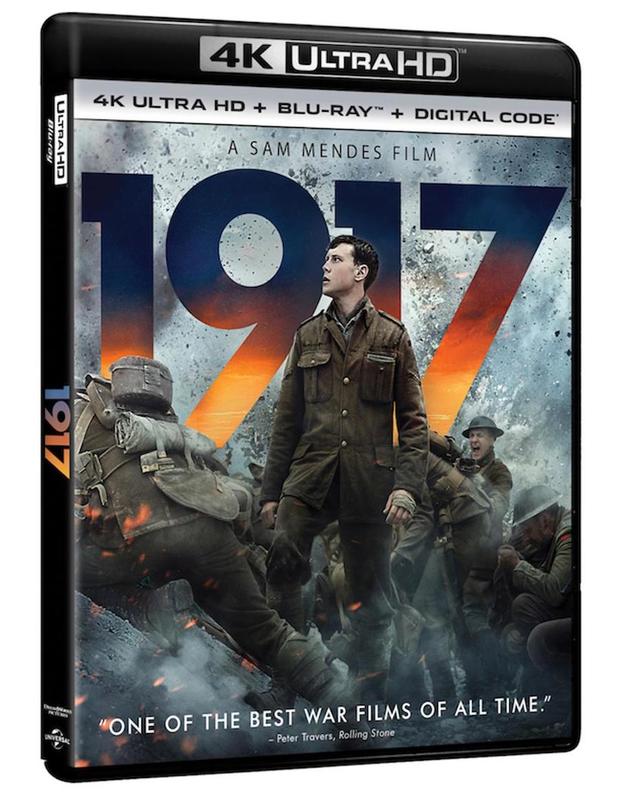
"1917" follows British Lance Cpls. Blake and Schofield on a mission to deliver a "do not attack, it's a trap" message to officers commanding troops on the front lines. Director and screenwriter Sam Mendes collaborated with co-screenwriter Krysty Wilson-Cairns, cinematographer Roger Deakins, production designer Dennis Gassner and their crew to create the illusion that the story takes place in real time and with one continuous tracking shot.
That conceit accomplishes two amazing things. Viewers get a strong sense of just how poor communications were during the war and how little information officers had at their disposal when making life-and-death decisions.
More importantly, narrowing the focus makes the movie about the personal connection between two young soldiers and how they depend on each other as they embark on a seemingly impossible mission. The young actors, Dean-Charles Chapman (Blake) and George MacKay (Schofield), give moving performances that make all the technical wizardry actually work.
You can watch the first nine minutes of the movie in the video embedded below.
"1917" is also one of those rare movies with bonus features that deepen a viewer's appreciation and understanding of the film. The planning, rehearsal and use of cutting-edge camera technology is explained in detail, and the shots of how the camera was relayed from one part of the crew to another are almost as impressive as the movie itself.
Even more impressive are two feature-length commentary tracks, one from Mendes and the other from Deakins. Anyone who wants to understand how movies are made and why this film resonates so deeply with the people who made it should spend time with Sam and Roger.
"1917" won a slew of awards this year but came up short in the Oscar Best Picture race. It will probably go down alongside "Saving Private Ryan" as one of the best films to be denied that Oscar. (To be fair, "Parasite" is also a great movie, so the loss will never sting as much as the "Shakespeare in Love" win over "Saving Private Ryan.") The film did earn Deakins his second Oscar for cinematography and won well-deserved technical Oscars for visual effects and sound mixing.

Producer Pippa Harris has worked with Sam Mendes several times, going back to the underrated Marine Corps sniper movie "Jarhead" in 2005. She's also been an executive producer on the TV series "Call the Midwife" and "Penny Dreadful," where she first worked with "1917" screenwriter Wilson-Cairns.
In a conversation with Military.com, Harris explained the motivation behind making the movie and why the U.K. seems to have a deeper connection to the memory of World War I than we do in the United States.
Pippa Harris: My grandfather fought in the First World War, and obviously Sam's grandfather did too. Maybe that war means a lot more to us. We have a lot of memorials to the people who fell in the first world war everywhere around London and the U.K.
That lack of interest in the U.S. certainly wasn't a hindrance in terms of getting the movie set up. Amblin was a studio that we'd worked with before, and they were very keen to work with Sam again. They loved this idea, the idea of having the first World War as the backdrop for this much more intimate, character-driven thriller.
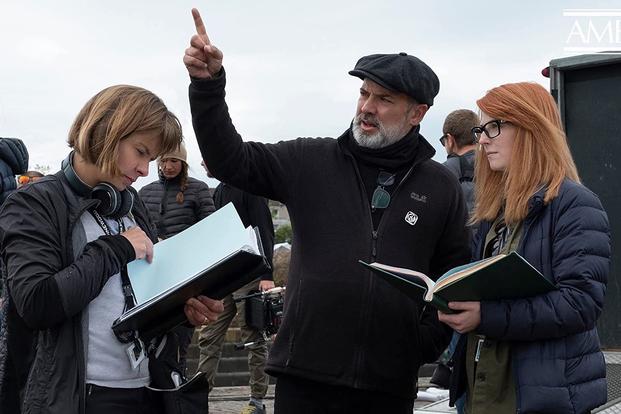
Krysty Wilson-Cairns earned an Oscar nomination for the "1917" screenplay, and the movie's bonus features make it obvious that she was on set and far more involved in the day-to-day production of this movie than most writers are on other productions.
The movie represents a huge breakthrough for a young writer whose previous credits are highlighted by a staff writer gig on "Penny Dreadful." Her career has since taken off, and she has upcoming movies in various stages of production with the gifted directors Edgar Wright ("Shaun of the Dead," "Baby Driver") and Tobias Lindholm ("A War," "A Hijacking").
In an interview, Wilson-Cairns explained her interest in the Great War.
Krysty Wilson-Cairns: I'm really fascinated by the First and Second World Wars. My grandfather never fought. He was born in 1929, so he was too young to fight in either one. He obviously did his military service in Britain and everything like that as well. He wasn't highly educated. He believed in understanding history, how important it was to have a very robust working knowledge of the mistakes civilization has made and the heroism and sacrifice that people went through so we could live the lives we were entitled to live.
My grandfather really believed in learning and reading about those things, and passed on that love to me. There was a graveyard near our house that had an RAF monument from the Second World War with a beautiful poem on it that said, "For your tomorrow, we gave our today." I still remember it years later. My grandfather was the main influence in my life. He took me to see "Saving Private Ryan" in the cinema when it came out, and every Sunday we'd watch a war movie together.
I had always dreamed of writing a war movie and sometimes, when you're a young woman, you're not usually afforded an opportunity to work on one, especially not at this level. When Sam wanted to tell a story based on his grandfather's war experience, I was lucky to be at the right place at the right time.
Military.com: "1917" isn't a movie that's particularly heavy on dialogue. The visual storytelling is remarkably important to how the movie works.
Wilson-Cairns: Screenwriting is a very visual medium. Ideally, when someone reads your script, it should put the movie in their head. Since the movie's story is told in real time, we don't start at the beginning of Blake and Schofield's friendship. We don't learn about Schofield's life because people don't wake up in the morning and say, "Oh, I'm missing my wife and her name is. ..." We couldn't use a lot of dialogue because that wouldn't feel real and it's not how soldiers talk with each other, especially in that war.
Dean Charles Chapman and George MacKay could tell so much of the story through their work that I was actually advocating cutting dialogue a lot of the time, which is very unusual for a writer. We worked with [cinematographer] Roger Deakins, who's arguably the greatest living visual storyteller, and [production designer] Dennis Gassner to tell the story of these two young men trying to deliver a message.
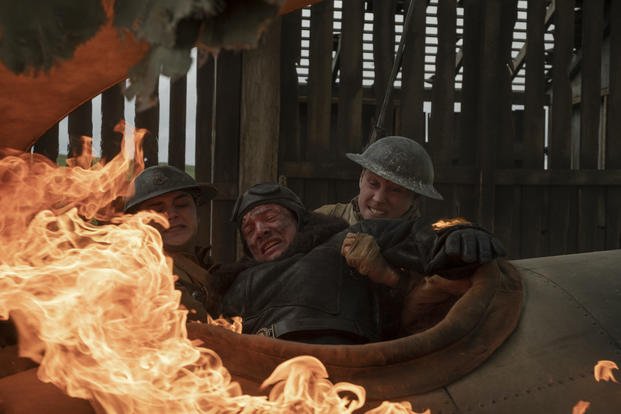
Military.com: There seems to be a more active memory of World War I in the U.K. than we have here in the States.
Wilson-Cairns: In the United Kingdom, millions died and the war touched every village, every town. Almost every young man was involved in the war effort in some way and so were most of the women. There are towns called "Thankful Villages" where all the boys came back from the war, and there's only a few of them in the entire United Kingdom. That's the level of devastation from the war.
Town squares and train stations and department stores from that era have plaques to remember all the young men who fell. In Scotland, there are little villages on the northeast coast that only have a little rocky path for access. Even they have war memorials because they lost men in the war.
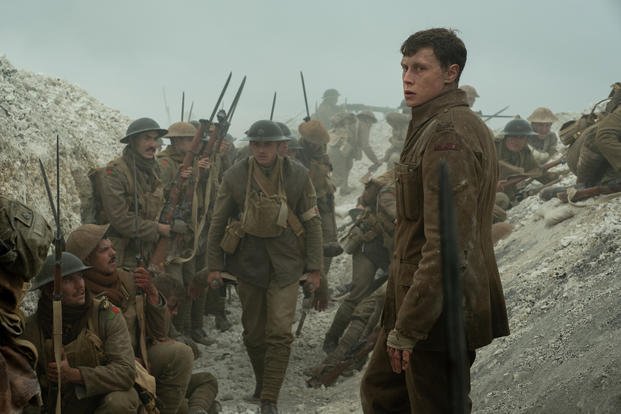
The Second World War is more of a clear-cut war in that the Allies were really fighting evil, because the Nazis were trying to destroy our civilization and our humanity. In the First World War, Brits and Germans were forced to fight each other because Europeans royals who were family members got in a spat a couple of years ago. That's not really an obvious reason to go and die. In the Second World War, you're sacrificing for humanity.
Now, when you read about the First World War, you do it with hindsight. It's very easy to ask, "Why did they send all those men to their deaths? What were they doing in that first year at the Somme? What were they thinking?"
If you try and place yourself in the shoes of the men who had to command that war, I wouldn't wish that unenviable position on my worst enemy. You've got no idea what's happening. You've got no radar. No modern technology. They had soldiers who carried birds in cages on their back and would release the birds when they took a German position, to let command know.
At the same time, there's a massive advancement in the technology used to kill people. You start the war with cavalry and end with tanks, chemical warfare and machine-gun artillery. With mines under the ground, you can wipe out 10,000 people, but you can't communicate with your frontline men 500 yards away other than by messenger, and about half of those messengers are getting blown up.
During this war, everyone doesn't really know quite what's going on. People have different stories and are just trying to keep themselves alive. That was the point of telling "1917" this way. One note scribbled in ink on paper is literally the difference between life and death for thousands of men. That's a profound thing that could've only really happened at that time and during that war.
